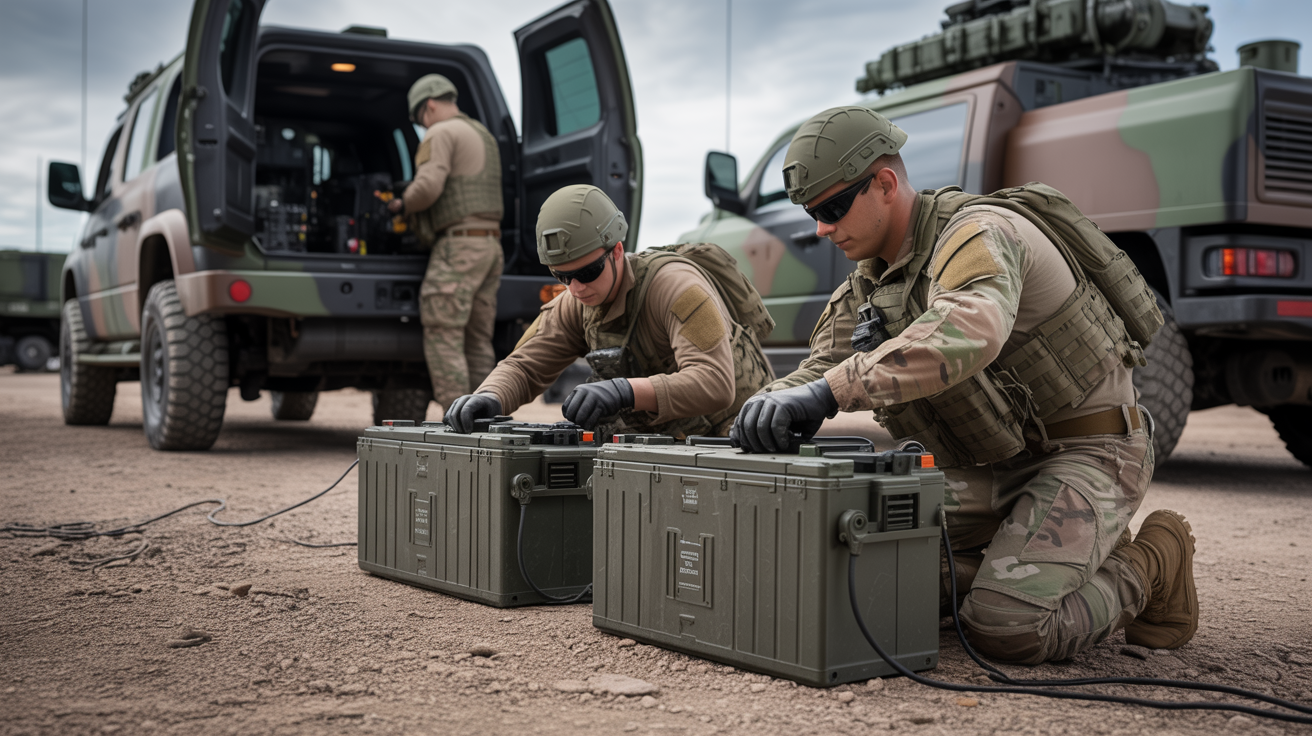Choosing Batteries for Military Field Applications
Comprehensive guide to selecting ruggedized batteries for military operations, including critical specifications, performance requirements, and field deployment considerations that can mean the difference between mission success and failure.

Mission-Critical Requirements
Military battery systems must operate reliably in extreme conditions where failure can compromise missions and endanger lives. This guide covers essential specifications and selection criteria based on real-world military deployments.
Understanding Military Battery Requirements
Military field applications present unique challenges that civilian battery systems simply cannot handle. From the Arctic tundra to desert heat, from high-altitude operations to underwater missions, military batteries must perform flawlessly across an extreme range of conditions while maintaining the highest levels of safety and reliability.
Primary Performance Requirements
Environmental Resilience
- • Wide temperature operation: -40°F to 140°F (-40°C to 60°C)
- • Shock and vibration resistance
- • Water and dust ingress protection (IP67+)
- • Electromagnetic interference (EMI) immunity
- • Altitude operation capability
Operational Performance
- • Consistent power output under load
- • Extended runtime for mission duration
- • Rapid recharge capability
- • Long shelf life without maintenance
- • Silent operation for stealth missions
Critical Military Specifications and Standards
Defense Standards Compliance
Military batteries must comply with rigorous defense standards that ensure reliability and interoperability across all branches of the military:
Key Military Standards
Environmental Testing
- • MIL-STD-810H - Environmental Engineering
- • MIL-STD-461 - EMI/EMC Requirements
- • MIL-STD-464 - Electromagnetic Compatibility
Safety & Performance
- • UN38.3 - Lithium Battery Transport
- • UL1642 - Primary & Secondary Batteries
- • IEC62133 - Safety Requirements
Temperature Performance Requirements
Military operations span the globe's most extreme environments. Battery temperature performance is often the defining factor in equipment selection:
Arctic Operations
-40°F to -10°F (-40°C to -23°C)
- • Cold weather charging capability
- • Insulated battery packs
- • Thermal management systems
Temperate Zones
-10°F to 100°F (-23°C to 38°C)
- • Standard operation parameters
- • Full performance capability
- • Normal charging protocols
Desert Operations
100°F to 140°F (38°C to 60°C)
- • High-temperature chemistry
- • Enhanced cooling systems
- • Thermal runaway protection
Battery Selection by Military Application
Communications Equipment
Military communications systems require uninterrupted power for extended periods, often in challenging RF environments:
Communications Battery Requirements
Primary Specifications
- • High energy density for extended runtime
- • Low electromagnetic signature
- • Quick-change capability for field replacement
- • Silent operation (no cooling fans)
Recommended Chemistry
- • LiFePO4 for safety and stability
- • Integrated BMS with RF shielding
- • Temperature compensation
- • Multiple voltage outputs
Vehicle and Aircraft Systems
Military vehicles and aircraft present unique power requirements with extreme vibration, G-forces, and temperature cycling:
Vehicle/Aircraft Battery Requirements
Mechanical Requirements
- • Shock resistance to 50G
- • Vibration tolerance per MIL-STD-810
- • Secure mounting systems
- • Flame-retardant casings
Electrical Requirements
- • High discharge rate capability
- • Multiple redundancy paths
- • EMI/EMC compliance
- • Battery monitoring systems
Portable Equipment
Soldier-carried equipment requires lightweight, high-energy batteries that can withstand the rigors of field operations:
- Weight optimization - Every ounce matters in field operations
- Ruggedized housings - Protection from drops, impacts, and environmental exposure
- Universal compatibility - Interchangeable across multiple equipment types
- Quick identification - Clear charge state indicators and identification markings
Selection Criteria and Decision Matrix
Critical Evaluation Factors
Battery Selection Priority Matrix
| Factor | Priority Level | Key Considerations |
|---|---|---|
| Safety | Critical | Thermal runaway protection, fail-safe mechanisms |
| Reliability | Critical | Mission success depends on battery performance |
| Environmental Range | High | Global deployment requirements |
| Energy Density | High | Weight and space constraints |
| Cycle Life | Medium | Long-term operational costs |
Cost vs. Performance Analysis
Military battery selection must balance performance requirements with total cost of ownership:
High-Cost Failures
- • Mission failure due to power loss
- • Equipment damage from battery failure
- • Logistics costs for emergency resupply
- • Personnel safety risks
Value of Reliability
- • Mission success and troop safety
- • Reduced maintenance requirements
- • Lower total cost of ownership
- • Simplified logistics and training
Implementation and Deployment Best Practices
Field Testing and Validation
Before full deployment, military batteries must undergo rigorous field testing:
- Environmental chamber testing - Simulate extreme temperature conditions
- Shock and vibration testing - Military standard compliance verification
- Field trials - Real-world testing in operational environments
- Accelerated life testing - Predict long-term performance
Training and Maintenance Protocols
Training Requirements
Proper training on battery handling, charging protocols, and safety procedures is essential for successful military deployments.
- • Battery safety and handling procedures
- • Proper charging techniques for field conditions
- • Troubleshooting and diagnostic procedures
- • Emergency response protocols
Conclusion and Recommendations
Selecting batteries for military field applications requires a comprehensive understanding of operational requirements, environmental challenges, and safety considerations. The cost of battery failure in military operations far exceeds the initial investment in high-quality, proven systems.
Key Recommendations
- 1. Prioritize safety and reliability over cost - Mission success depends on power system reliability
- 2. Specify wide temperature operation - Global deployment requires -40°F to 140°F capability
- 3. Require comprehensive testing - Verify performance under actual field conditions
- 4. Plan for lifecycle support - Include training, maintenance, and replacement strategies
- 5. Work with experienced suppliers - Military experience and proven track record are essential
"In military operations, battery failure is not just an inconvenience—it can be a matter of life and death. The investment in proven, extreme temperature battery technology pays for itself many times over through mission success and troop safety."
Expert in military battery systems with over 20 years of experience developing and deploying power solutions for defense applications. Darrell has worked directly with military contractors and government agencies to develop battery systems for ground vehicles, aircraft, and soldier-portable equipment.